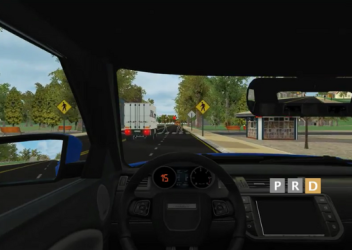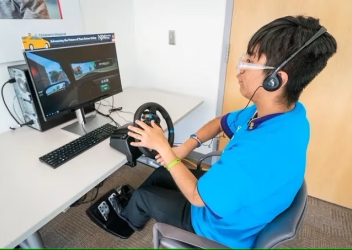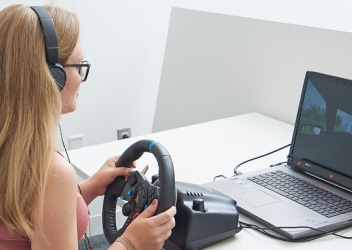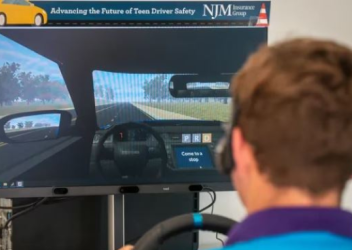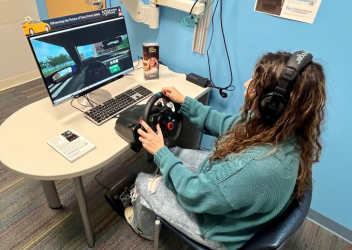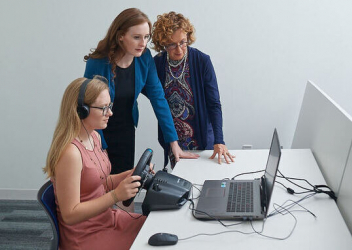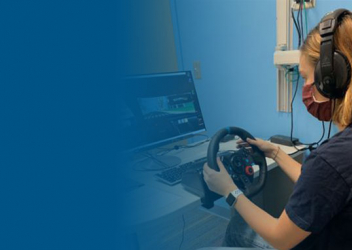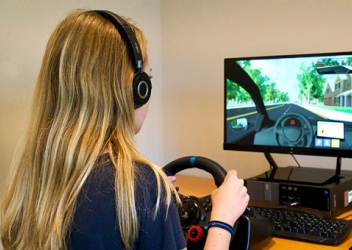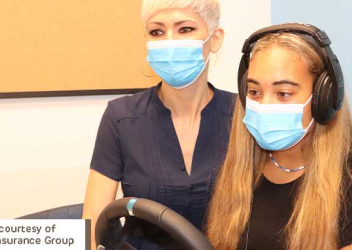Virtual Driving Assessment
Developed and validated by researchers at Children's Hospital of Philadelphia (CHOP), the virtual driving assessment was exposes drivers to common serious crash scenarios to measure their ability to drive safely and avoid crashes. It utilizes the Ready-Assess™ platform, an AI-driven virtual driving assessment that provides the driver with the insights and tools to improve.
Ready-Assess™ was initially piloted and validated with over 40,000 driver license applicants in a partnership with the Ohio Department of Public Safety and the Ohio Bureau of Motor Vehicles. The results confirmed that the assessment is able to predict licensing outcomes.
Other research using the virtual driving assessment in Ohio published in Pediatrics found that driving skills measured at the time of licensure helps predict crash risk in newly licensed drivers.
After completing the virtual driving assessment, teens (and their families) receive high-quality, personalized feedback on their crash-avoidance skills, including tips to improve and links to videos created by CHOP experts to develop specific driving skills.
Virtual Driving Assessment Research Projects
- Ohio Portable Driving Simulator System Pilot (2017-2019)
-
CIRP collaborated with Diagnostic Driving, Inc., the Ohio Department of Public Safety, and the Ohio Bureau of Motor Vehicles (BMV) to adapt and pilot a previously validated virtual driving test, Ready-Assess™, to identify underprepared new license applicants as part of the licensing process and before the state's on-road exam. Results demonstrated the PDSS was highly scalable and could accurately detect underprepared applicants.
Principal Investigators: Flaura Winston, MD, PhD, Elizabeth Walshe, PhD
Funding: National Highway Traffic Safety Administration and the State of Ohio
Read the October 2020 Health Affairs Article About the Ohio Pilot's Implications for Policy
Read a report about the Ohio PDSS pilot
Read a blog post about the research
Read more about Diagnostic Driving, Inc. and its software-as-a-service product, Ready-Assess™
- Implementation of Virtual Driving Assessment in Primary Care Practices
- Through a collaboration with CHOP Care Network Operations and CIRP, The Possibilities Project at CHOP is piloting the use of the virtual driving assessment (VDA) at select CHOP primary care offices using an innovative implementation approach. Practices receive on-site training and the support of a dedicated implementation team, but each practice is encouraged to include the driving assessment in a way that works best for their individual work flow. For example, one practice may prefer that teens complete the VDA before their wellness visit, while others after the visit.
Initial feedback from both teens and their families has been extremely positive, finding the VDA easy to use and helpful in determining next steps for skill development. Once fully operational across the CHOP Primary Care Network, CIRP researchers plan to measure the program’s impact on licensing and crash data among young people in New Jersey and Pennsylvania.
Principal Investigators: Alex Fiks, MD, MSCE, Flaura Winston, MD, PhD, Elizabeth Walshe, PhD
Funding: NJM Insurance Group
Read a blog post about assessing young drivers in primary care
Read a press release about the project
Watch a video about the project
- License Examination Crash Outcomes Post-Licensure in Young Drivers: Do the Youngest Drivers Crash the Most?
This large, prospective population-based study of 2018 Ohio licensing data shows age-related differences in licensing and crash outcomes that track with age-related licensing policies in Ohio. CIRP researchers compared data from 136,643 license applicants between the ages of 16 and 24 with tracked licensed driver crash outcome data from up to one year after licensure for 129,897 of those drivers.
The study found that drivers who were licensed at age 18, making them exempt from comprehensive licensing requirements that include behind the wheel training had the highest crash rates in the first year of licensure of all those licensed under the age of 25. Compared with drivers licensed at age 18, those licensed at age 16 had 27% lower crash rates over the first two months of licensure and 14% lower crash rates over the first 12 months of licensure. Compared with drivers licensed at 18, those licensed at age 17 had 19% lower crash rates over the first 2 months of licensure and 6% lower crash rates over the first 12 months of licensure. In addition, 16-year-old license applicants performed best of all those licensed under age 25 on the on-road license examination, with a 22% failure rate compared with a 37% failure rate at age 18.
When accounting for socioeconomic status (SES), those in the lowest 10th percentile SES neighborhoods had statistically significantly higher crash rates than those living in the highest 10th percentile SES neighborhoods and were more likely to fail their first on-road driving exam, suggesting the importance of making comprehensive driver training more affordable.
Funding: Eunice Kennedy Shriver Institute of Child Health and Development of the National Institutes of Health; National Highway Traffic Safety Administration; Ohio Bureau of Motor Vehicles; Annenberg Policy Center at the University of Pennsylvania; NJM Insurance Group
Read the study abstract
Read a press release about the study
Read a blog post about the study
- Novel Use of a Virtual Driving Assessment to Classify Driver Skill at the Time of Licensure
Using data from a virtual driving assessment (VDA) implemented into the licensing workflow in Ohio, this study compared the VDA performance of nearly 33,000 license applicants to their on-road examination results. Researchers created a set of Driving Skill Clusters that represent driving performance in areas including vehicle control, braking, acceleration, and tendency to speed or tailgate. They then grouped results with these clusters into four driving classes: 1) No issues (careful and skilled); 2) Minor Issues (minor vehicle control deficits); 3) Major Issues (vehicle control problems with reckless/risk-taking behaviors); 4) Major Issues with Dangerous Behaviors (more reckless/risk-taking behaviors).
Those in the No Issues and Minor Issues classes were 29% and 11% less likely to fail the on-road examination, while those in the Major Issues and Major Issues with Dangerous Behaviors classes were 34% and 19% more likely to fail the on-road examination. This study shows that license applicants can be classified based on their driving skills at the time of licensure. Future studies will validate these Skill Cluster classes in relation to their prediction of post-licensure crash outcomes.
Principal Investigator: Elizabeth Walshe, PhD
Funding: Eunice Kennedy Shriver Institute of Child Health and Development of the National Institutes of Health; National Highway Traffic Safety Administration; Ohio Bureau of Motor Vehicles; Annenberg Policy Center at the University of Pennsylvania; NJM Insurance Group
Read the study abstract
Read a news article about the study
- Keep It Brief and Targeted: Driving Performance Feedback Report Features to Use With Novice Drivers
A key way to improve teen driver safety is to develop driving evaluations that can help novice drivers develop crucial skills instead of just providing pass/fail information. This study aimed to inform driving feedback report design to not only include skill development information, but also to ensure ease of use and understandability. Participants ages 18–25 years were recruited from CloudResearch Prime Panels to rate 1 of 9 report design formats with various combinations of five key features: 1) performance summary, 2) action plan (AP) length, 3) AP order, 4) AP grading system, and 5) peer comparison. They then completed questionnaires.
Results show that feedback reports designed with a performance summary and a short, targeted action plan starting with the biggest area for improvement are most likely to motivate novice drivers to take action to improve skills and are also easy to use and understand.
Principal Investigator: Chelsea Ward McIntosh, MS, CCRP
Funding: NJM Insurance Group
Read the study abstract
Read a blog post about the research
- Driving Skills at Licensure and Time to First Crash
Using a virtual driving assessment (VDA) implemented in the licensing workflow in Ohio, this study examined how virtual driving skill classification measured at the time of licensure can predict crash risk, post-licensure, in newly licensed young drivers. This observational study utilized a linked dataset of VDA, state licensing and crash record data, to examine 16,914 young drivers (under 25 years) who completed the VDA at the time of licensure, and their subsequent police-reported crash records. Using the outcome of time-to-first crash, a Cox proportional hazard model was used to estimate the risk of crash during the follow-up period as a function of VDA Driving Class (and Skill Cluster) membership.
Results show that VDA driving skills measured at licensure predicted crash risk post-licensure: specifically, the best performing No Issues Driving Class had a crash risk 10% lower than average risk (95% CI 13% - 6%), while the Major Issues with Dangerous Behavior Class had a crash risk 11% higher than average (95% CI 1% - 22%). This is the first population-level study showing that young driver skills measured at the time of licensure can predict crash risk early in licensure, paving the way for targeted and personalized interventions before the period of highest crash risk.
Principal Investigator: Elizabeth Walshe, PhD
Funding: Eunice Kennedy Shriver Institute of Child Health and Human Development of the National Institutes of Health, the US National Highway Traffic Safety Administration through the Ohio Traffic Safety Office, the State of Ohio's Department of Administrative Services, Annenberg Public Policy Center of the University of Pennsylvania, and NJM Insurance Group.
Read a press release about the study
Read the abstract
Read a blog post about the research
Read a Forbes article about the study
Watch a video about our research that shows the virtual driving assessment can predict crash risk in newly licensed young drivers:





